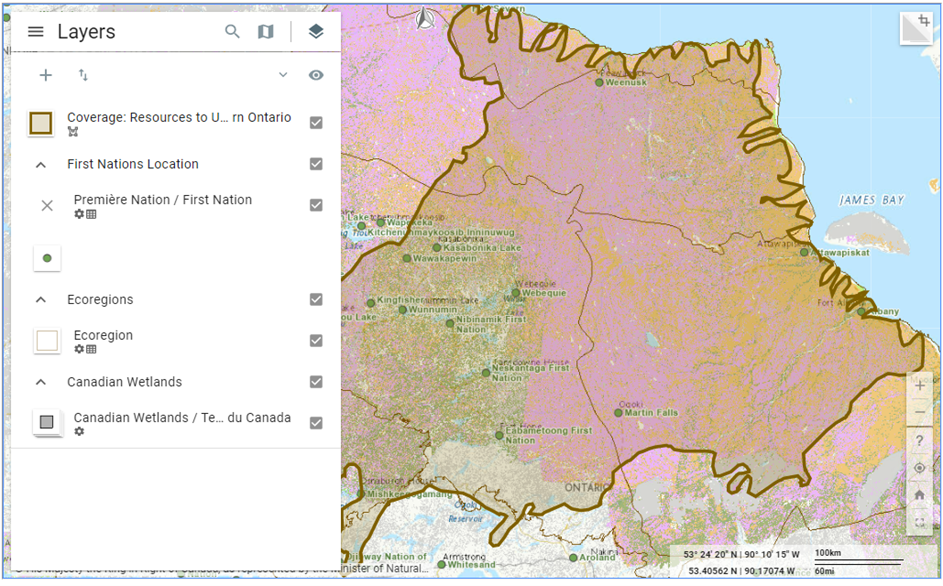Resources to Understand Cumulative Effects in Northern Ontario
What are cumulative effects?
As industrial and other development expands, adverse effects can accumulate and combine across space and time: we refer to these as ‘cumulative effects’.
Researchers generate key data and knowledge on the past, present, or future state of environmental, health, social and economic conditions. This can also include looking at changes caused by human activities and natural processes, and the interactions between the two.
- Learn more and view a video about cumulative effects on the Platform’s Learn about Cumulative Effects page.
- Read up on how the Government of Canada understands, considers and supports the management of cumulative effects.
Co-led by Natural Resources Canada and Environment and Climate Change Canada, the Open Science and Data Platform provides a single point of access to cumulative effects-related science, data and information about development and regulatory activities from federal, provincial and territorial governments. Governments, Indigenous Peoples, environmental non-governmental organizations, academic researchers and development project proponents, for example, can now search the platform based on their region of interest and learn about the potential effects of proposed projects, and use the information to inform decisions.
Understanding Cumulative Effects in Northern Ontario
Northern Ontario is an example of an area that represents an opportunity to look at cumulative effects more closely. It is of interest for several reasons including for its use for traditional purposes by several First Nations communities, its global significance as a carbon reservoir and its biodiverse habitat.
For example, the Hudson and James Bay lowland peatlands are part of one of the world’s largest wetland networks, and they offer a wide range of ecological benefits, including serving as critical habitat to species at risk and storage of an estimated 35 billion tonnes of carbon. The watersheds in the region also support a wealth of biodiversity including critical habitat for globally significant fish like Lake Sturgeon, wildlife like Woodland Caribou, and migratory bird populations.
Northern Ontario is also home to one of the largest deposits of chromite on the continent. According to the Canadian Critical Minerals Strategy, if extracted sustainably, critical minerals like chromite, nickel, copper, chromium, platinum and palladium could play an integral role in Canada’s transition to a clean economy through use in manufacturing clean energy technologies, like electric vehicles, solar panels and wind turbines. “Accelerating the development of Canada’s critical mineral sector, while ensuring environmental sustainability and respecting the rights of Indigenous peoples, is essential if Canada is to seize upon this generational opportunity and position itself as a stable supplier of critical minerals, both at home and abroad” states the Strategy. Environmental sustainability and critical mineral development can both be achieved as Canada advances “nature forward” approaches, seeking to incorporate practices that prevent biodiversity loss, protect species at risk and support nature protection.

Curated Collection: Resources to Understand Cumulative Effects in Northern Ontario
The Government of Canada’s Open Science and Data Platform provides access to a curated collection of geographically relevant datasets (61) and scientific publications (19) within the area delineated by several large secondary watersheds in Northern Ontario: the Attawapiskat, Winisk, Ekwan, Upper Albany, and Lower Albany watersheds.
Given the importance of the region, a carefully curated collection of scientific publications and data was created and made accessible on the Open Science and Data Platform to ensure key information is openly accessible to help users better understand, or assess, the potential effects of development in the watershed regions of northern Ontario.
A careful balance for future development activities
Through federal impact assessment legislation, Canada is committed to assessing the potential effects of projects in a timely manner, while also ensuring the highest standards of protection. This includes considering the cumulative effects of proposed industrial activity within traditional territories or regions. Major projects such as mining, energy and infrastructure projects are being assessed under the Impact Assessment Act, within the context of combined effects from past, present, and reasonably foreseeable future activities and natural processes. Federal assessments are informed by science, Indigenous Knowledge and perspectives, and stakeholder feedback on cumulative effects.
“Canada’s vast area and resource-based economy mean that we must work hard to balance development with both socio-economic and environmental considerations such as climate change, biodiversity conservation, and effects on human health”, says Dr. Ranjana Sharma, Natural Resources Canada’s Chief Scientist. “By increasing access to data and science, the Open Science and Data Platform can play a key role.”
In February 2020, the Minister of the Environment and Climate Change announced the decision to undertake a Regional Assessment in the Ring of Fire Area. For more information, visit the Regional Assessment in the Ring of Fire Area Web page on the Canadian Impact Assessment Registry.